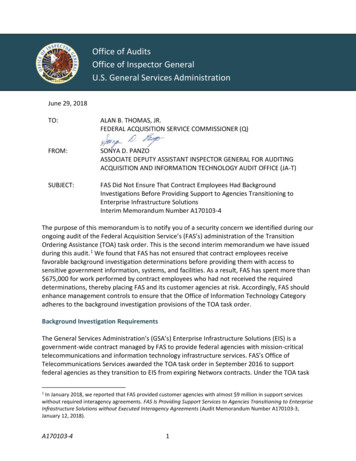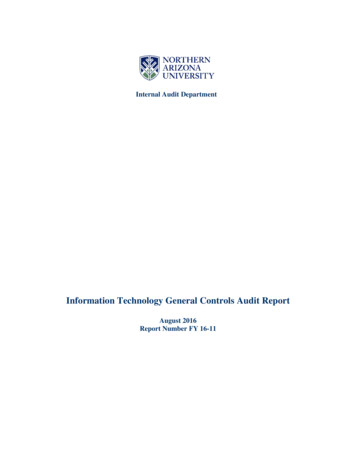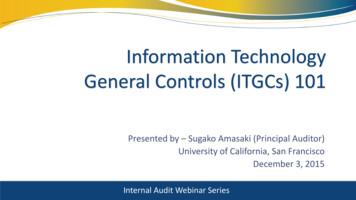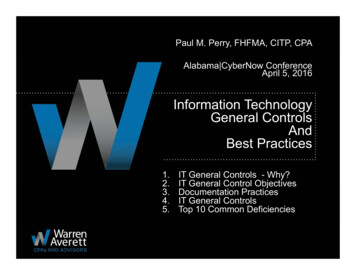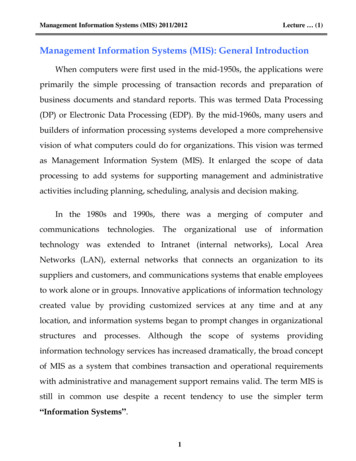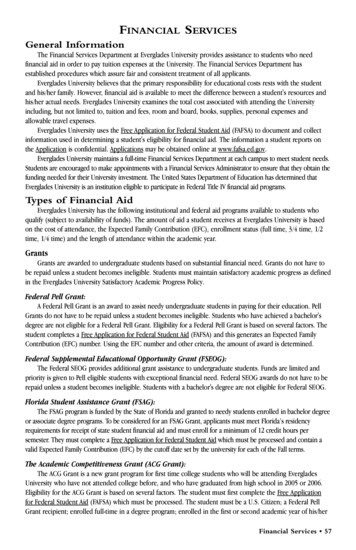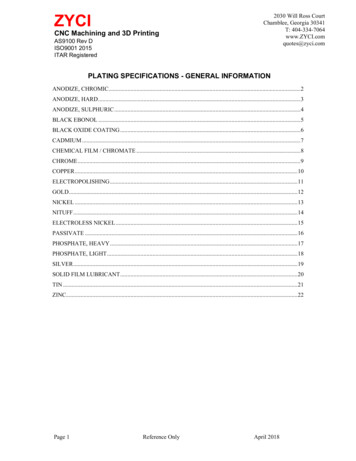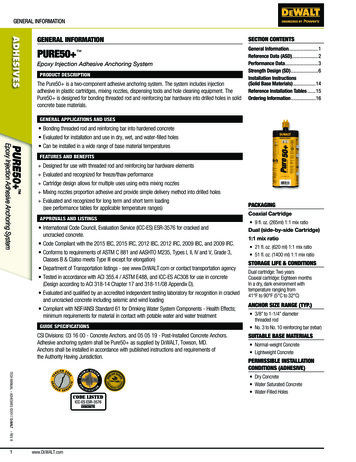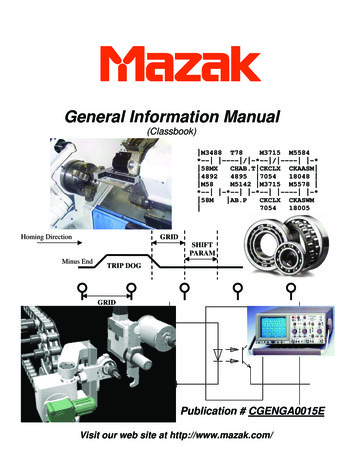
Transcription
Return to Main MenuGeneral Information Manual(Classbook) M3488 T78M3715 M5584*-- ---- / -*-- / ---- -* 58MXCHAB.T CKCLX CKAASM 48924895 705418048 M58M5142 M3715 M5578 *-- -*-- -*-- ---- -* 58M AB.PCKCLX CKASWM 705418005Homing DirectionGRIDSHIFTPARAMMinus EndTRIP DOGGRIDPublication # CGENGA0015EVisit our web site at http://www.mazak.com/
Return to Main Menu
Return to Main MenuNotes:
Return to Main MenuTABLE OF CONTENTSSection-1ABOUT MAZAKMazak’s Integrated Solutions Agile Manufacturing . .Technology Solutions .Optimum Support . .12918Section-2CROSS REFERENCESRegional Support Facilities .Machine Model Codes .Publication Designation Number .Conversions .Torque Specifications .Parameters for Maintenance .Hydraulic Symbols .Oil / Air Lubrication .Machine Requirement List .International Electrical Codes .Parts Ordering Instructions 125678913152834Section-3TURNING MACHINE CENTERSMachine Tool Building Concept Leveling Procedure .Alignment Examples .Home Set-up Examples .Stroke Diagram Tool Eye Calibration .123567Section-4HORIZONTAL MACHINE CENTERSMachine Tool Building Concept Leveling Procedure .Alignment Examples .Home Set-up Examples .Stroke Diagram Horizontal Tool Changer & Measure Examples .Tool Length Measure Calibration .1236789Section-5VERTICAL MACHINE CENTERSMachine Tool Building Concept . .Leveling Procedure .Alignment Examples .Home Set-up Examples .Stroke Diagram Vertical Tool Changer & Measure Examples .Tool Lengh Measure Calibration .1235678
Return to Main MenuSection-6BEARING INFORMATIONTypes of Bearings .Bearing Load Direction .Roller Bearing Preload .Bearing Combinations . .Angular Contact Preload Guide Layout Methods .Ball Screw Layout Methods .Inspection and Adjustment of Gibs .Bearing Glossary Terms 123456111516Section-7BACKLASH AND HOME ADJUSTMENTSMachining Center Backlash .Turning Center Backlash .Home Return Process 159Section-8ELECTRICAL INFORMATIONElectrical Circuit Diagrams . .Diagnosis Monitor Screen .Ladder Monitor Function . .Servo System .PLG Adjustment .90K & 256 PLG Adjustment .1815222736Section-9MICRO DISK INFORMATIONParameter Settings .Disk Formatting .Operation .Alarm Messages .Troubleshooting .Specifications .169282930Section-10ASSEMBLY PROCEDURESKey Alignment .Pipe Plugs . .Packing and Seals .Characteristics of Bearings Inserting Oil Seals .Sky Packing .Proximity Switch .Solenoid Valves .Modular Valves Quick Seal Coupling .Adjusting an Auto Switch .Snap Rings .Proper Wire Crimping .Proper Wire Soldering ZL Connectors .12471415161719202324252933
Return to LibrarySAFETY PRECAUTIONS6) Do not deface, scratch or remove any cautionplate. Should it become illegible or missing,order another caution plate from the supplier,specifying the part number shown at the lowerright corner of the plate. BEFORE POWERING UPDANGER:Cables, cords or electric wires whose insulationis damaged can produce current leaks andelectric shocks.Before using, check theircondition.WARNING:1) Be sure the instruction manual and theprogramming manual are fully understoodbefore operating the machine. Every functionand operating procedure should be completelyclear.2) Use approved oil resistant safety shoes, safetygoggles with side covers, safe clothes, andother safety protection required.3) Close all NC unit, operating panel, electriccontrol panel doors and covers.CAUTION:1) The power cable from the factory feeder switchto the machine main circuit breaker shouldhave a sufficient sectional area to handle theelectric power used.2) Cables which must be laid on the floor must beprotected from hot chips, by using rigid orother approved conduit, so that short-circuitswill not occur.3) Before first time operation of the machine afterunpacking it or from being idle for a long periodof time (several days or more), each slidingpart must be sufficiently lubricated. To do so,push and release the pump button severaltimes until the oil seeps out on the slidingparts. The pump button has a return spring, sodo not force it to return.4) Oil reservoirs should be filled to indicatedlevels. Check and add oil, if needed.5) For lubrication points, oil specification andappropriate levels, see the various instructionplates.6) Switches and levers should operate smoothly.Check that they do.7) When powering the machine on, turn on theswitches in the following order: first the factoryfeeder switch, then the machine main circuitbreaker, and then the control power on switchlocated on the operating panel.8) Check the coolant level, and add coolant, ifneeded.The machine is provided with a number of safetydevices to protect personnel and equipment frominjury and damage.Operators should not,however, rely solely upon these safety devices,but should operate the machine only after fullyunderstanding what special precautions to take byreading the following documentation thoroughly. BASIC OPERATING PRACTICESDANGER:1) Some control panels, transformers, motors,junction boxes and other parts have highvoltage terminals. These should not be touchedor a severe electric shock may be sustained.2) Do not touch any switches with wet hands.This too, can produce an electric shock.WARNING:1) The emergency stop pushbutton switchlocation should be well known, so that it can beoperated at any time without having to look forit.2) Before replacing a fuse, turn off the mainincoming power switch to the machine.3) Provide sufficient working space to avoidhazardous falls.4) Water or oil can make floors slippery andhazardous. All floors should be clean and dryto prevent accidents5) Do not operated any switch without a thoroughunderstanding of the actions about to be taken.6) Avoid accidental operation of switches.7) Work benches near the machine must bestrong enough to hold materials placed onthem to prevent accidents. Articles should beprevented from slipping off the bench surface.8) If a job is to be done by two or more persons,coordinating signals should be given at eachstep of the operation. The next step should notbe taken unless a signal is given andacknowledged.CAUTION:1) In the event of power failure, turn off the maincircuit breaker immediately.2) Use the recommended hydraulic oils, lubricantsand grease or acceptable equivalents.3) Replacement fuses should have the propercurrent ratings.4) Protect the NC unit, operating panel, electriccontrol panel, etc. from shocks, since thiscould cause a failure or malfunction.5) Do not change parameters or electricalsettings. If changes are unavoidable, recordthe values prior to the change so that they canbe returned to their original settings, ifnecessary.S-1
Return to Main Menu AFTER CONTROL POWER IS TURNED ONCAUTION:When the control power “ON” switch on theoperating panel is on, the "READY" lamp onthe operating panel should also be on (check tosee that it is).4) Tools and other items around the machine orequipment should be stored to ensure goodfooting and clear aisles.5) Do not place tools or any other items on theheadstock, turret, covers and similar places(For T/M).CAUTION:1) Tool lengths should be within specifiedtolerances to prevent interference.2) After installing a tool, make a trial run. ROUTINE INSPECTIONSWARNING:When checking belt tensions, do not get yourfingers caught between the belt and pulley.CAUTION:1) Check pressure gages for proper readings.2) Check motors, gear boxes and other parts forabnormal noises.3) Check the motor lubrication, and sliding partsfor evidence of proper lubrication.4) Check safety covers and safety devices forproper operation.5) Check belt tensions. Replace any set of beltsthat have become stretched with a freshmatching set. OPERATIONWARNING:1) Do not work with long hair that can be caughtby the machine. Tie it back, out of the way.2) Do not operate switches with gloves on. Thiscould cause mis-operation.3) Whenever a heavy workpiece must be moved,if there is any risk involved, two or more peopleshould work together.4) Only trained, qualified workers should operateforklift trucks, cranes or similar equipment andapply slings.5) Whenever operating a forklift truck, crane orsimilar equipment, special care should be takento prevent collisions and damage to thesurroundings.6) Wire ropes or slings should be strong enoughto handle the loads to be lifted and shouldconform to the mandatory provisions.7) Grip workpieces securely.8) Stop the machine before adjusting the coolantnozzle at the tip.9) Never touch a turning workpiece in the spindlewith bare hands, or in any other way.10) To remove a workpiece from the machine otherthan by a pallet changer, stop the tool andprovide plenty of distance between theworkpiece and the tool (for M/C).11) While a workpiece or tool is turning, do notwipe it off or remove chips with a cloth or byhand. Always stop the machine first and thenuse a brush and a sweeper.12) Do not operate the machine with the chuck andfront safety covers removed (For T/M).13) Use a brush to remove chips from the tool tip,do not use bare hands .14) Stop the machine whenever installing orremoving a tool.15) Whenever machining magnesium alloy parts,wear a protective mask. WARM UPCAUTION:1) Warm up the machine, especially the spindleand feed shaft, by running the machine for 10to 20 minutes at about one-half or one-third themaximum speed in the automatic operationmode.2) The automatic operation program should causeeach machine component to operate. At thesame time, check their operations.3) Be particularly careful to warm up the spindlewhich can turn above 4000 rpm.If the machine is used for actual machiningimmediately after being started up following along idle period, the sliding parts may be worndue to the lack of oil. Also, thermal expansionof the machine components can jeopardizemachining accuracy. To prevent this condition,always make sure that the machine is warmedup. PREPARATIONSWARNING:1) Tooling should conform to the machinespecifications, dimensions and types.2) Replace all seriously worn tools with new onesto prevent injuries.3) The work area should be adequately lighted tofacilitate safety checks.S-2
Return to Main MenuCAUTION:1) Thoroughly read and understand the safetyprecautions in the instruction manual.2) Thoroughly read the whole maintenancemanual and fully understand the principles,construction and precautions involved. MAINTENANCE OPERATIONDANGER:1) Those not engaged in the maintenance workshould not operate the main circuit breaker orthe control power "ON" switch on theoperating panel. For this purpose, "Do notTouch the Switch, Maintenance Operation inProgress!" or similar warning should beindicated on such switches and at any otherappropriate locations. Such indication shouldbe secured by a semi-permanent means in thereading direction.2) With the machine turned on, any maintenanceoperation can be dangerous. In principle, themain circuit breaker should be turned offthroughout the maintenance operation.WARNING:1) The electrical maintenance should be done bya qualified person or by others competent to dothe job.Keep close contact with theresponsible person. Do not proceed alone.2) Overtravel limit and proximity switches andinterlock mechanisms including functional partsshould not be removed or modified.3) When working at a height, use steps or ladderswhich are maintained and controlled daily forsafety.4) Fuses, cables, etc. made by qualifiedmanufacturers should be employed. BEFORE OPERATION & MAINTENANCE BEGINSWARNING:1) Arrange things in order around the section toreceive the maintenance, including workingenvironments. Wipe water and oil off parts andprovide safe working environments.2) All parts and waste oils should be removed bythe operator and placed far enough away fromthe machine to be safe.CAUTION:1) The maintenance person should check that themachine operates safely.2) Maintenance and inspection data should berecorded and kept for reference.CAUTION:1) During automatic operation, never open themachine door. Machines equipped with thedoor interlock will set the program to singlestep.2) When performing heavy-duty machining,carefully prevent chips from being accumulatedsince hot chips from certain materials cancause a fire. TO INTERRUPT MACHININGWARNING:When leaving the machine temporarily aftercompleting a job, turn off the power switch onthe operation panel, and also the main circuitbreaker. COMPLETING A JOBCAUTION:1) Always clean the machine or equipment.Remove and dispose of chips and clean coverwindows, etc.2) Make sure the machine has stopped running,before cleaning.3) Return each machine component to its initialcondition.4) Check the wipers for breakage.Replacebroken wipers.5) Check the coolant, hydraulic oils and lubricantsfor contamination. Change them if they areseriously conta
1)Be sure the instruction manual and the programming manual are fully understood before operating the machine. Every function and operating procedure should be completely clear. 2)Use approved oil resistant safety shoes, safety goggles with side covers, safe clothes, and other safety protection required. 3) Close all NC unit, operating panel .

